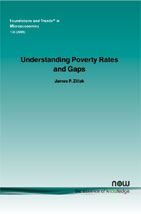Understanding Poverty Rates and Gaps: Concepts, Trends, and Challenges
By James P. Ziliak, Department of Economics, 335 Gatton B&E Building, University of Kentucky, USA, jziliak@uky.edu
Abstract
I survey key developments in applied and theoretical research on poverty rates and poverty gaps over the past two decades, and provide a detailed analysis of poverty trends across a variety of income measures and poverty indexes. Included is an extensive summary of how poverty thresholds and economic resources are measured and several proposed recommendations for revision. In addition I discuss axiomatically derived alternatives to the standard poverty rate that provide estimates not only of the incidence of poverty, but also the intensity and the inequality of poverty. The empirical analysis shows that while poverty rates fell in the late 1990s, deep poverty held steady and even rose for broad income measures that include the usual private and public income sources along with in-kind transfers such as food stamps and subsidized housing, and tax credits such as the EITC. I conclude with a discussion of a number of new challenges facing poverty measurement, especially issues of data quality in the Current Population Survey, and recommendations for future research and policy on poverty measurement.
Understanding Poverty Rates and Gaps
Understanding Poverty Rates and Gaps surveys key developments in applied and theoretical research on poverty rates and poverty gaps over the past two decades, providing a detailed analysis of poverty trends across a variety of income measures and poverty indexes. The author extensively summarizes how poverty thresholds and economic resources are measured and examines several proposed recommendations for revision. In addition, axiomatically derived alternatives to the standard poverty rate are discussed. These provide estimates not only of the incidence of poverty, but also the intensity and the inequality of poverty. The empirical analysis shows that while poverty rates fell in the late 1990s, deep poverty held steady and even rose for broad income measures. Understanding Poverty Rates and Gaps concludes with a discussion of a number of new challenges facing poverty measurement and recommendations for future research and policy.
